How to Measure Brand Performance? [2025]
Table of contents
How well is your brand doing? You can easily check it by measuring your brand performance. To do that, you need to pay attention to some key metrics. Also, you need to compare your performance to competitors to understand your market position. Keep reading to find out how!
Table of contents:
- What is brand performance?
- How to measure brand performance?
- Benchmark with the competitors
- Conclusion
What is brand performance?
Brand performance refers to the analysis of a brand’s activities and strategies. The goal is to determine how effectively a brand achieves its objectives and how well it positions in the marketplace compared to its competitors. It includes several metrics that offer valuable insights into the brand’s health, awareness, equity, and more.
Measuring brand performance is necessary for businesses to:
- Understand how customers perceive the brand.
- Determine the brand’s market position and competitive standing.
- Evaluate the Return on Investment (ROI) of marketing and branding initiatives.
- Monitor the overall health and equity of the brand.
- Identify opportunities for growth and expansion.
Check your brand performance!
How to measure brand performance?
Measuring brand performance involves tracking metrics that are key for your business.
So, in the first step, you should determine which metrics are most relevant to your business goals. These could include brand awareness, reputation score, share of voice, etc.
Then, benchmark your brand against competitors to understand your relative position in the market.
Key brand performance metrics:
- Brand Awareness
- Presence Score
- Brand Reputation
- Brand Equity
- Brand Loyalty
- Share of Voice (SOV)
- Market Share
- Digital channels distribution
- Social media reach
- SEO metrics
- Return on Investment (ROI)
- Customer Lifetime Value (CLV)
01 Brand Awareness
Brand awareness indicates how familiar your target audience is with your brand.
Brand awareness sits at the top of the marketing funnel. Before consumers can consider purchasing, they must first know that the brand exists.
High brand awareness increases the likelihood of a brand being included in the consumer’s set of choices when they are ready to make a purchase. The higher the brand awareness, the better.
How to measure brand awareness? There are some key brand awareness metrics you need to be familiar with. They will help you judge how effectively your brand has penetrated the market.
Check your brand performance!
02 Presence Score
The Presence Score is a metric within the Brand24 tool that measures your brand’s popularity and activities across the internet, especially in the context of social media and other digital platforms.

Discover our client’s success story — read the case study.
A higher score usually means that your brand is being mentioned more often across the web, which can translate into greater brand familiarity.
Here, you can see the Presence Score of Oreo:

By providing a real-time Presence Score, Brand24 allows you to monitor sudden changes in your brand’s online presence, enabling quick responses to potential PR crises.
03 Brand Reputation
Brand reputation is a critical aspect of a company’s overall health and performance in the market. This involves understanding how consumers and stakeholders perceive your brand.
A strong reputation establishes trust with customers, investors, and partners. Trust is the foundation of customer loyalty.
A company’s reputation can affect its market value. If a company has a good reputation, its stock prices may increase. But if it has a bad reputation, its market value may decrease.
Ultimately, brand reputation can drive long-term growth. It can lead to higher sales, better partnerships, and sustained success over time.
There are a few ways to measure a brand’s reputation:
- Conduct sentiment analysis: Use a media monitoring tool, for example, Brand24, to track mentions of your brand across various platforms. The tool categorizes mentions as positive, neutral, or negative. Analyze these mentions to understand public opinion.
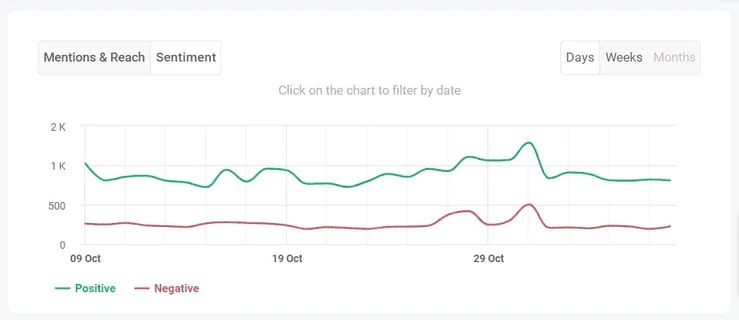
- Check Reputation Score: The Reputation Score is a Brand24 metric that represents how your brand is perceived across the internet. It takes into account sentiment and reach analysis. The higher the score, the better. Regular checks of your Reputation Score can help identify specific issues affecting your brand’s reputation, allowing for targeted reputation management and strategic PR campaigns.

- Conduct emotion analysis: By analyzing the emotions associated with your brand, you can understand how customers truly feel about your products or services. It gives insight into your brand perception. The Brand24 tool detects whether they feel admiration, sadness, etc. Insights into the emotional reactions of customers can guide improvements in customer service and user experience.

04 Brand Equity
Brand equity refers to the value that a brand adds to a product or service. It encompasses consumer perceptions, experiences, and attitudes toward the brand, which can affect how they interact with it and the premium they’re willing to pay.
It is an essential component of brand performance because it influences current sales and impacts long-term growth.
Checking brand equity is a way to assess how much value the brand contributes to the company’s products or services and its overall standing in the marketplace.
You can measure brand equity by:
- Comparing the price of your brand’s product with a non-branded or generic product.
- Calculating the additional revenue generated because of the brand.
Check your brand performance!
05 Brand Loyalty
Brand loyalty provides insights into the strength of a brand’s relationship with its customers. It translates into repeat purchases. Loyal customers continue to choose your brand over competitors, ensuring a steady revenue stream.
Customers who are loyal to a brand are often willing to pay a premium, showing less price sensitivity. Also, they are less likely to switch to competitors, even in the face of aggressive marketing or pricing strategies. This provides a competitive advantage and can help maintain market share.

Customer loyalty often leads to word-of-mouth marketing, as loyal customers recommend the brand to friends and family. This organic form of marketing is highly effective and cost-efficient.
High brand loyalty contributes positively to the overall brand image. You can measure it by:
- Calculating the proportion of customers who come back to make additional purchases within a given timeframe. A high repeat purchase rate indicates strong brand loyalty.
- Measuring the churn rate is the percentage of customers who stop doing business with a company over a specific period. A lower churn rate suggests higher loyalty.
06 Share of Voice (SOV)
Share of Voice (SOV) is a measurement of the market your brand owns compared to your competitors, often used in the context of advertising and media presence.
A higher SOV means your brand is more present in marketing channels that your target audience sees. This often leads to increased brand awareness among your target audience. A higher SOV can help you stand out in your industry and gain a competitive edge.
Here, you can see the SOV of Nike, Adidas, and Reebok calculated by the Brand24 tool:
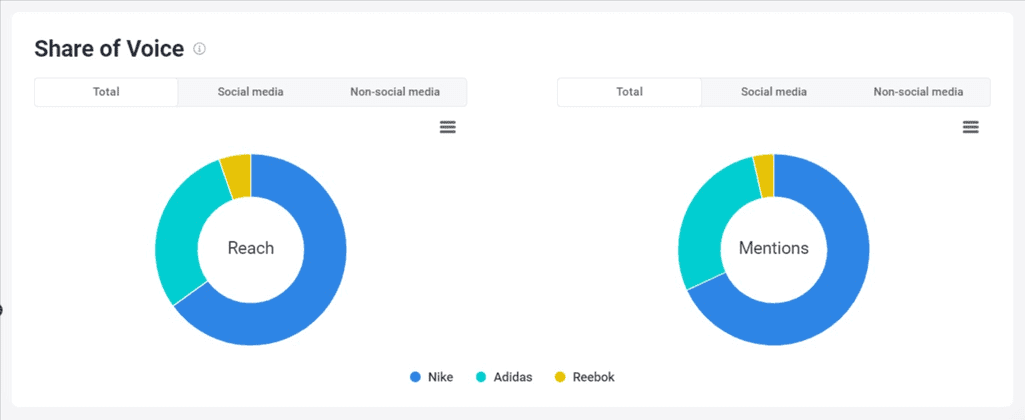
07 Market Share
Market share allows you to compare your brand’s performance with competitors directly. It reflects the effectiveness of your sales and brand marketing efforts.
An increasing market share suggests that your tactics are working, while a decreasing share may indicate that your approaches are less effective than those of your competitors.
Measuring market share usually involves calculating the portion of total sales in your industry or product category that is attributable to your company.
Here’s a short guide on how to measure market share:
- Obtain data on total sales in the market. This can come from industry reports, market research firms, trade associations, or public financial records.
- Calculate your company’s total sales over the same period and within the same market you’re examining.
- Once you have your market share figure, analyze it in the context of previous periods to identify trends.
08 Digital channels distribution
Checking digital channel distribution is crucial for understanding how your brand’s content performs across different online platforms.
By analyzing the performance of each marketing channel, you can effectively allocate your budget to those that provide higher ROI.
Media monitoring tools will help you detect which channels generate the most online buzz. The volume of mentions can indicate brand visibility.
Knowing which channels have the highest number of mentions helps you understand where your brand is most visible and where you might need to increase your presence.
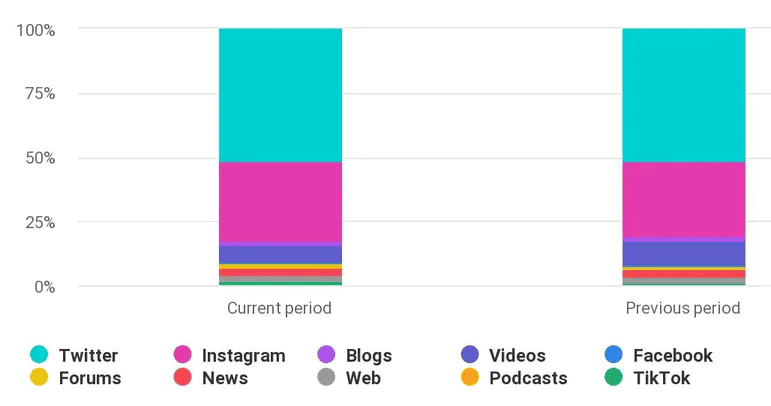
09 Social media reach
Reach measures how many people have seen your brand’s content. A higher reach means more people are becoming aware of your brand, which is essential for building brand recognition.
Social media reach reflects the extent of your brand’s potential audience on social media channels. Monitoring reach helps ensure that your content is penetrating your target audience.
Changes in reach can indicate broader market trends. A sudden increase might mean your brand is gaining popularity, while a decrease could signal a shift in consumer interests or behaviors.
If you’re collaborating with influencers or other brands, social media reach can help you measure the impact of these partnerships.
Analyzing the reach of different types of content can inform your content strategy. You can focus on creating more of the content that has the broadest reach.
Most social media platforms offer their own analytics tools. But you can also use various third-party tools to aggregate data across multiple social platforms. These tools often provide more comprehensive analytics, including reach and other engagement metrics.
Here, you can see the reach chart inside the Brand24 tool:
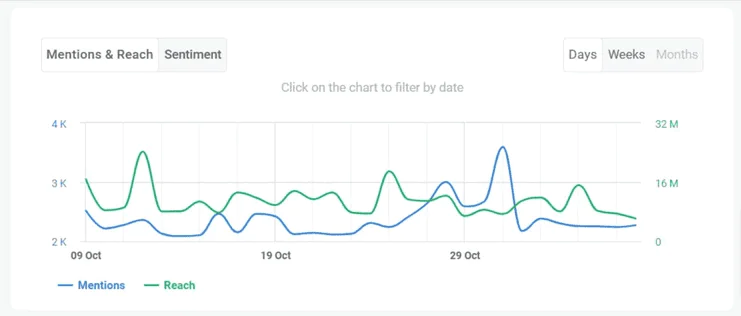
10 SEO metrics
SEO metrics are crucial for measuring and building strong brand performance. They help us understand how well a brand is performing through organic search.
High rankings for relevant keywords mean more visibility for your brand, which is crucial for driving organic traffic to your website. Tracking keyword rankings helps to understand how well your content aligns with what your audience is searching for.
Measuring the SEO metrics requires using tools such as Ahrefs, Semrush, Google Analytics, or Google Search Console.
Here are some important metrics to follow:
- Organic traffic
- Keyword rankings
- Traffic value
- Organic traffic conversions
- Backlinks
- Indexed pages

11 Return on Investment (ROI)
ROI helps you determine which marketing campaigns and channels are generating the most value relative to their cost. This allows you to allocate your budget more effectively and invest in the highest-performing marketing channels.
In any business, it’s essential to justify expenditures by showing tangible results. ROI measures the financial return of branding activities and marketing efforts.
Measuring Return on Investment (ROI) involves quantifying both the cost of your investment and the revenue attributed to that investment.
Here’s how to measure it, particularly for marketing and branding efforts:
- Determine all costs associated with the marketing or branding campaign, including creative and production costs, media spending, staff salaries, agency fees, and any other associated costs.
- Track the direct results of your investment. This might include increased sales revenue, lead generation, conversions attributed to the specific campaign, etc.
- Calculate the ROI percentage: ROI=(Net Profit / Total Cost of Campaign) × 100
Check your brand performance!
12 Customer Lifetime Value (CLV)
Customer Lifetime Value (CLV) estimates the total revenue a company can expect from a single customer throughout the business relationship.
CLV helps you understand the profitability of your customer base. Knowing the value a customer brings over their lifetime can inform how much resource you should allocate to acquire and retain them.
This metric allows for more effective customer segmentation. It identifies which customer groups are the most valuable. Therefore, you can focus on marketing strategies with maximum return on investment.
To calculate CLV, multiply customer value by the average customer lifespan: CLV= Customer Value x Average Customer Lifespan
Benchmark with the competitors
As you already know which brand performance metrics are important, it’s time to compare your results to competitive brands and companies.
You can use a Brand24 for this purpose. The tool collects the key brand metrics and insights. Thanks to the comparison feature, you can benchmark periods and competitors.
Let’s compare Nike, Adidas, and Rebook. Which brand has the strongest performance?
The overview clearly shows that Nike won the competition race by gathering over 565K online mentions during the last 30 days.
25% of those mentions are positive, while only 8% are negative. That’s a great result!
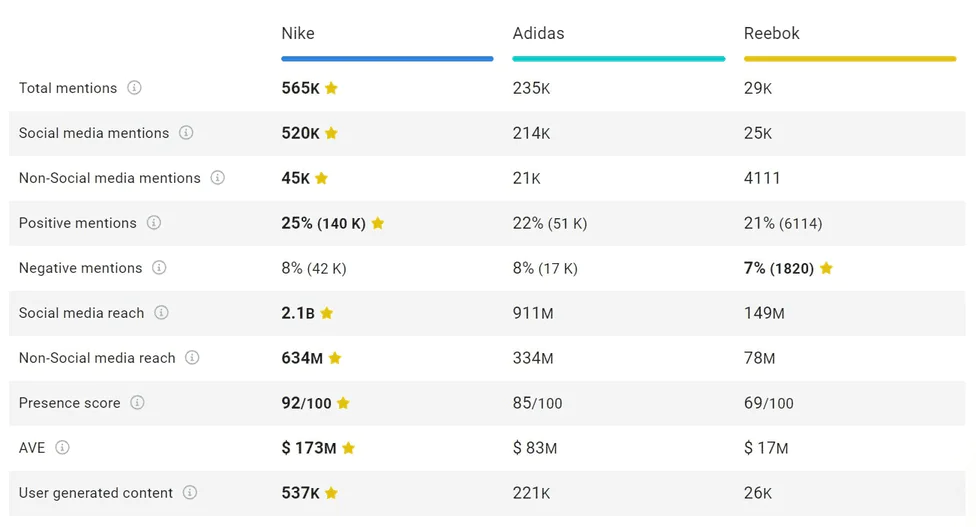
As a result, Nike has enormous social media and non-social reach.

What’s interesting is that the sentiment around those three brands is quite similar.
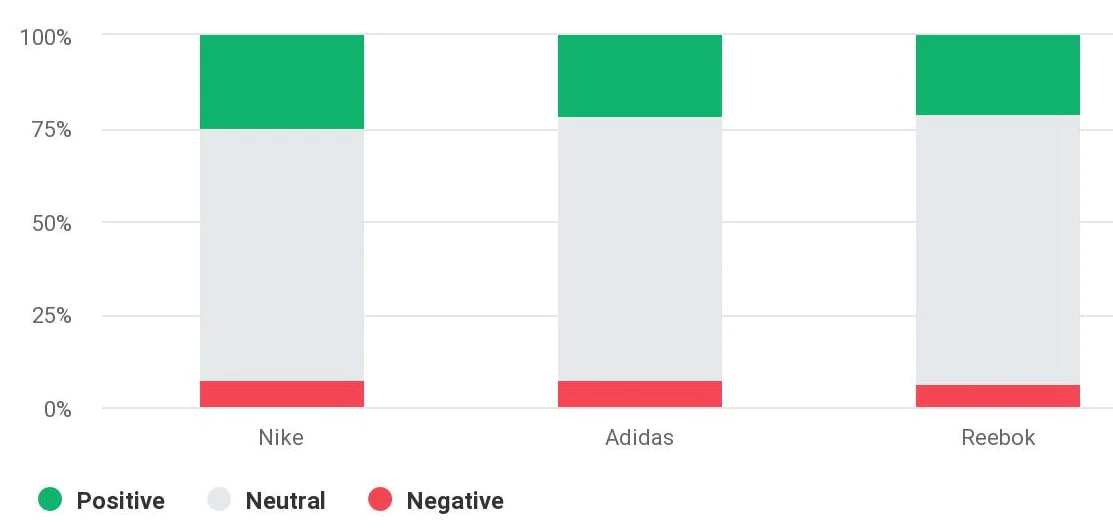
Check your brand performance!
Conclusion
You can measure brand performance by tracking the key performance indicators I listed above.
Final tips:
- To truly gauge your brand’s performance, you need to look at the big picture. This involves monitoring large amounts of data, such as sales numbers, website metrics, sentiment analysis, online reach, etc. Each data point contributes to a larger picture, giving you a comprehensive view of your brand’s current position.
- Evaluating brand performance can be made less complicated by utilizing the right tools. Social media analytics platforms, media monitoring software, and SEO analytics tools enable you to gather and analyze data. It is important to equip yourself with software that can effectively track the various metrics relevant to your brand.
- The marketplace is constantly evolving, and brand performance metrics can change quickly. Remember about constant monitoring of key performance indicators.
As you probably noticed, you will need some great tools to measure and analyze the data.
Want to track reach, sentiment, share of voice, and other metrics? Try Brand24 for free!
Related articles



![How to Conduct a Brand Audit? The 5 Step Guide [2025]](https://brand24.com/blog/app/uploads/2022/01/How-to-Conduct-a-Brand-Audit-_052022.png)
![Guide to Brand Monitoring + TOOLS [2025 update]](https://brand24.com/blog/app/uploads/2019/08/Top-10-brand-monitoring-tools.png)

![How to Measure Marketing Performance? [2025]](https://brand24.com/blog/app/uploads/2024/04/marketing_performance-600x335.webp)

![How to Measure Product Performance? [2025]](https://brand24.com/blog/app/uploads/2024/05/product_performance@2x-600x335.webp)
